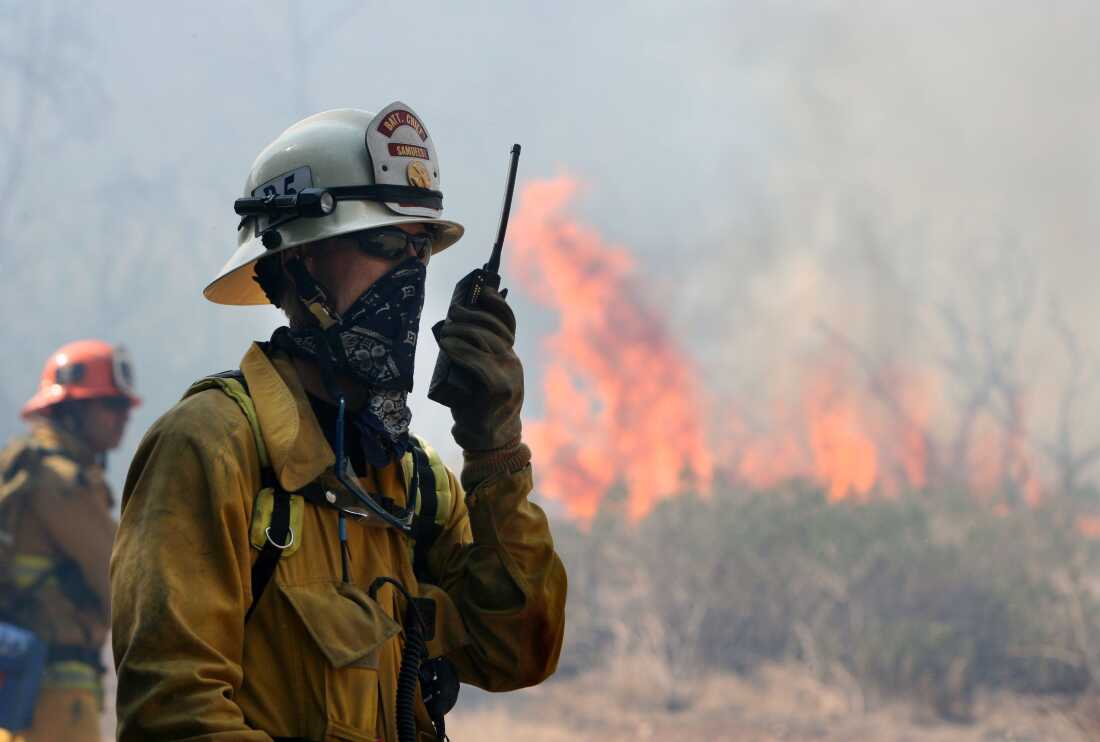
Garrett Keene sits on the front steps of his home in Lake Elsinore, Calif. that was destroyed in the Airport Fire, one of three major Southern California Fires so far this September. After evacuating with his family, Keene said he monitored the Watch Duty fire app to see where airdrops of fire retardant were happening as the fire approached, but none dropped on his neighborhood.
Gina Ferazzi/Los Angeles Times via Getty Images
hide caption
toggle caption
Gina Ferazzi/Los Angeles Times via Getty Images
As climate change contributes to longer wildfire seasons and increases the likelihood of destructive fires, more people in Western states find themselves searching for local wildfire information. But finding accurate, specific and timely information can be challenging, especially in the middle of an emergency.
“The world has now expected twitters and TikToks and push notifications, and the world of technology has passed over this community of first responders and firefighters and emergency managers,” says John Mills, co-founder and CEO of Watch Duty, an app launched in 2021 that has taken off in popularity as more and more people look to their phones for wildfires information.
“It’s really starting to blow up as the fires explode,” says Mills, whose app saw a spike in downloads in early September while three major fires raged in the mountains surrounding Los Angeles. “The sad part is it means that things are really getting extraordinarily bad when this happens.”
A firehose of information
During a wildfire, this information can come from many sources: emergency push notifications from county emergency managers, texts and emails from the sheriff’s department, social media posts from local, state, and federal firefighting agencies, and websites like Inciweb, which map firelines.

Mills, a Silicon Valley tech guy who lives off-the-grid in the woods of Sonoma County, experienced this jumble of information after a close brush with 2020’s Wallbridge Fire – part of a particularly bad wildfire summer across the West Coast, in which 33 people were killed just in California. Mills realized, “You know, it’s only a matter of time before it comes back for me.”
He realized he could do something about it—by building an app that would integrate all these sources of wildfire information and make it easily accessible on smartphones.
“Hey, I live in the woods, I’m gonna die, this has to get launched tomorrow,” Mills remembers thinking during that wildfire. “So we built Watch Duty in 80 days and got it live and had 50,000 users in a week.”
The app started relatively small, tracking fires across just three Northern California counties, but in four years, it has grown to include the whole American West, Texas and Oklahoma.
New technology, old techniques
Watch Duty doesn’t collect or sell user data. The basic version is free to download, and the non-profit that makes it is funded through donations and subscriptions to advanced and pro versions.
The app draws from various official sources of wildfire information.

Watch Duty organizes information on a map of the U.S., which is dotted with flame icons representing active wildfires. Click a flame, and details like evacuation zones, fire lines, containment percentage, and acres burned pop up. Choose to track a fire, and you’ll get push notifications for the most urgent updates, like new evacuation orders.
Mhari Shaw/NPR
hide caption
toggle caption
Mhari Shaw/NPR
Still, its strength comes from a small army of volunteer contributors and staff reporters with firefighting, emergency dispatch, and journalism experience who watch wilderness camera live streams and listen in on firefighter radio communications in the field.
Michael Silvester is one of these contributors— a staff reporter who started out as a volunteer. He often takes the Watch Duty night shift, posting live updates on active fires from his home across the Pacific, where he got his start as a radio scanner at a young age.
“My dad was a volunteer firefighter here in New Zealand,” he says. “I used that as a way of keeping track of him on calls and stuff.”
Silvester says one day, he became curious to see how much he could learn about wildfires in California, an entire hemisphere away, just by listening to live-streamed firefighter radio channels online. It turns out a lot—and his Twitter handle @CAFireScanner was born.
“Someone said I saved their life one day,” Silvester quietly recounts. “They didn’t know a fire was coming over the hill until they saw the message on Twitter.”
Now, he performs the same service on Watch Duty, which he says is a better platform to get the right information into the right hands.
“When you follow people like me on Twitter, you kind of have to get everything that I post. Will it be a fire in Southern California? Will it be a fire in Siskiyou County all the way at the other end of the state?” he describes.
“With Watch Duty, you can subscribe by county. It’s targeted information- it’s delivered to you.”
“This is a real-time operation, 24 hours a day,” says CEO Mills. “We talk to you through an app; we talk to you through your phones. But really we listen to radios, a 100-year-old technology,” he explains. “That’s really where you find out the most up-to-date, real-time intelligence. Because it actually is the firefighters doing the job in that moment.”
An ‘amazing tool,’ as part of a toolbox
“Watch Duty has definitely filled a gap,” says Karen Hancock, Public Information Officer and Community Outreach Specialist for the Sonoma County Fire District, one of the first counties covered by the app when it launched in 2021.

Watch Duty gets close-to-real-time information by listening in to the radio communications of firefighters on the front lines. In remote areas where radio signals are weak, Watch Duty has started setting up its own transmission towers to help with firefighting efforts and to give its staff reporters a way of listening for updates.
J. Emilio Flores/Getty Images
hide caption
toggle caption
J. Emilio Flores/Getty Images
“It has been an amazing tool for not only our public but for our firefighters and crews as well,” she says.
Hancock’s community is no stranger to wildfires. In 2017, the fast-moving Tubbs Fire swept through the Coffey Park neighborhood in the middle of the night with no warning, killing 22 people and burning over 5,000 structures. At the time, it was the most destructive fire in California history, but it soon became the second-most destructive after the Camp Fire raged through the town of Paradise one year later.

“We’ve learned that redundancy is really important,” says Hancock., whose job is to help community members stay prepared with the latest information. “But a lot of times we’re in the field, and we just can’t get it out fast enough because our hands are just so busy in that moment.”
CalFire, the California state wildfire agency, cautions that there are “potential risks associated with sharing inaccurate information inadvertently.” In a statement to NPR, CalFire said that they prefer people visit their website for information and that platforms like Watch Duty “should not be regarded as official sources of information.”
Hancock says she always recommends Watch Duty alongside more traditional information sources like local emergency notifications.“It’s just another tool, another way to get the information out,” she points out.
“There’s not that many of us first responders, and even a smaller handful of us that have the ability to put out those communications, you know, through social media or just those critical alerts that go out,” Hancock explains. “Having another resource that is reaching so many in the community– it’s lifesaving.”





